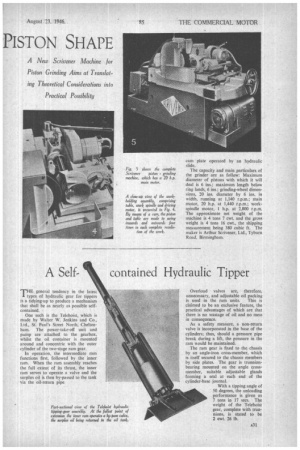A Self contained Hydraulic Tipper
Page 33

If you've noticed an error in this article please click here to report it so we can fix it.
T" general tondency in the latest types of hydraulic gear for tippers is a tidying-up to produce a mechanism that shall be as nearly as possible selfcontained.
One such is the Telehoist, which is made by Walter W. Jenkins and Co., Ltd., St. Paul's Street North, Cheltenham. The power-take-off unit and pump are attached to the gearbox, whilst the oil container is mounted around and concentric with the outer cylinder of the two-stage ram gear.
In operation, the intermediate ram functions first, followed by the inner ram. When the ram assembly reaches the full extent of its thrust, the inner ram serves to operate a valve and the surplus oil is then by-passed to the tank via the oil-return pipe. Overload valves are, therefore, unnecessary, and adjustable oil packing is used in the ram units. This is claimed to be an exclusive feature, the practical advantages of which are that there is no wastage of oil and no mess in consequence.
As a safety measure, a non-return valve is incorporated in the base of the cylinders; thus, should a pressure pipe break during a lift, the pressure in the ram would be maintained.
The ram gear is fixed to the chassis by an angle-iron cross-member, which is itself secured to the chassis members by side plates. The gear is trunnionbearing mounted on the angle crossmember, suitable adjustable glands forming a seal at each end of the cylinder-base journal.
With a tipping angle of • 50 degrees, the unloading performance is given as 7 tons in 17 secs. The weight of the Telehoist gear, complete with trunnions, is stated to be 2 cwt. 26 lb.




































































